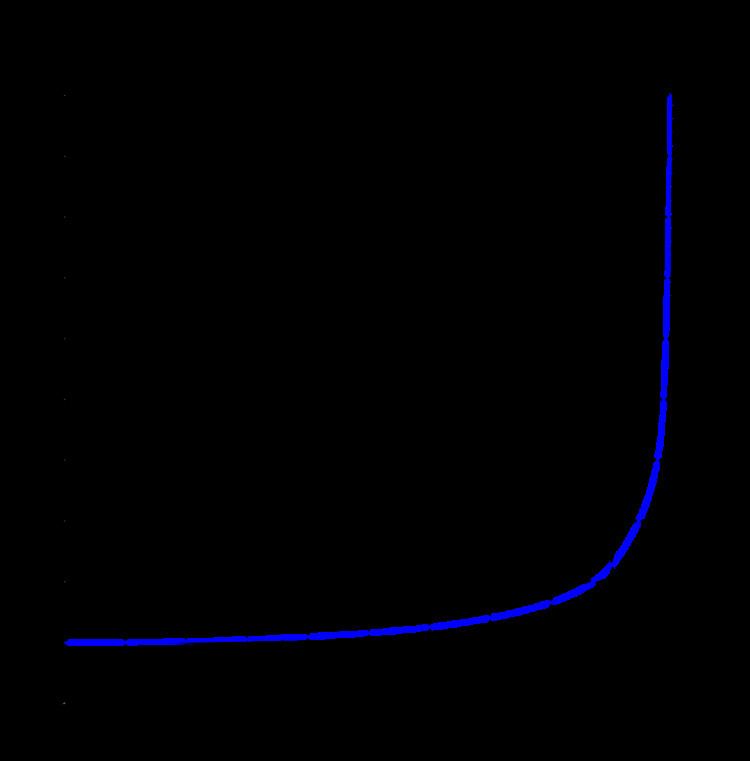 | ||
The Lorentz factor or Lorentz term is the factor by which time, length, and relativistic mass change for an object while that object is moving. The expression appears in several equations in special relativity, and it arises in derivations of the Lorentz transformations. The name originates from its earlier appearance in Lorentzian electrodynamics – named after the Dutch physicist Hendrik Lorentz.
Contents
- Definition
- Occurrence
- Numerical values
- Alternative representations
- Momentum
- Rapidity
- Series expansion velocity
- Applications in astronomy
- References
Due to its ubiquity, it is generally denoted with the symbol γ (Greek lowercase gamma). Sometimes (especially in discussion of superluminal motion) the factor is written as Γ (Greek uppercase-gamma) rather than γ.
Definition
The Lorentz factor is defined as:
where:
This is the most frequently used form in practice, though not the only one (see below for alternative forms).
To complement the definition, some authors define the reciprocal:
see velocity addition formula.
Occurrence
Following is a list of formulae from Special relativity which use γ as a shorthand:
Corollaries of the above transformations are the results:
Applying conservation of momentum and energy leads to these results:
Numerical values
In the table below, the left-hand column shows speeds as different fractions of the speed of light (i.e. in units of c). The middle column shows the corresponding Lorentz factor, the final is the reciprocal. Values in bold are exact.
Alternative representations
There are other ways to write the factor. Above, velocity v was used, but related variables such as momentum and rapidity may also be convenient.
Momentum
Solving the previous relativistic momentum equation for γ leads to:
This form is rarely used, it does however appear in the Maxwell–Jüttner distribution.
Rapidity
Applying the definition of rapidity as the following hyperbolic angle φ:
also leads to γ (by use of hyperbolic identities):
Using the property of Lorentz transformation, it can be shown that rapidity is additive, a useful property that velocity does not have. Thus the rapidity parameter forms a one-parameter group, a foundation for physical models.
Series expansion (velocity)
The Lorentz factor has the Maclaurin series:
which is a special case of a binomial series.
The approximation γ ≈ 1 + 1/2 β2 may be used to calculate relativistic effects at low speeds. It holds to within 1% error for v < 0.4 c (v < 120,000 km/s), and to within 0.1% error for v < 0.22 c (v < 66,000 km/s).
The truncated versions of this series also allow physicists to prove that special relativity reduces to Newtonian mechanics at low speeds. For example, in special relativity, the following two equations hold:
For γ ≈ 1 and γ ≈ 1 + 1/2 β2, respectively, these reduce to their Newtonian equivalents:
The Lorentz factor equation can also be inverted to yield:
This has an asymptotic form of:
The first two terms are occasionally used to quickly calculate velocities from large γ values. The approximation β ≈ 1 - 1/2 γ−2 holds to within 1% tolerance for γ > 2, and to within 0.1% tolerance for γ > 3.5.
Applications in astronomy
The standard model of long-duration gamma-ray bursts (GRBs) holds that these explosions are ultra-relativistic (initial
Subatomic particles called muons, have a relatively high lorentz factor and therefore experience extreme time dilation. As an example, muons generally have a half-life of about 2.2μs which means muons generated from cosmic ray collisions at about 10km up in the atmosphere should be non-detectable on the ground due to their decay rate. However, it has been found that ~10% of muons are still detected on the surface, thereby proving that to be detectable they have had their decay rates slow down relative to our inertial frame of reference.
